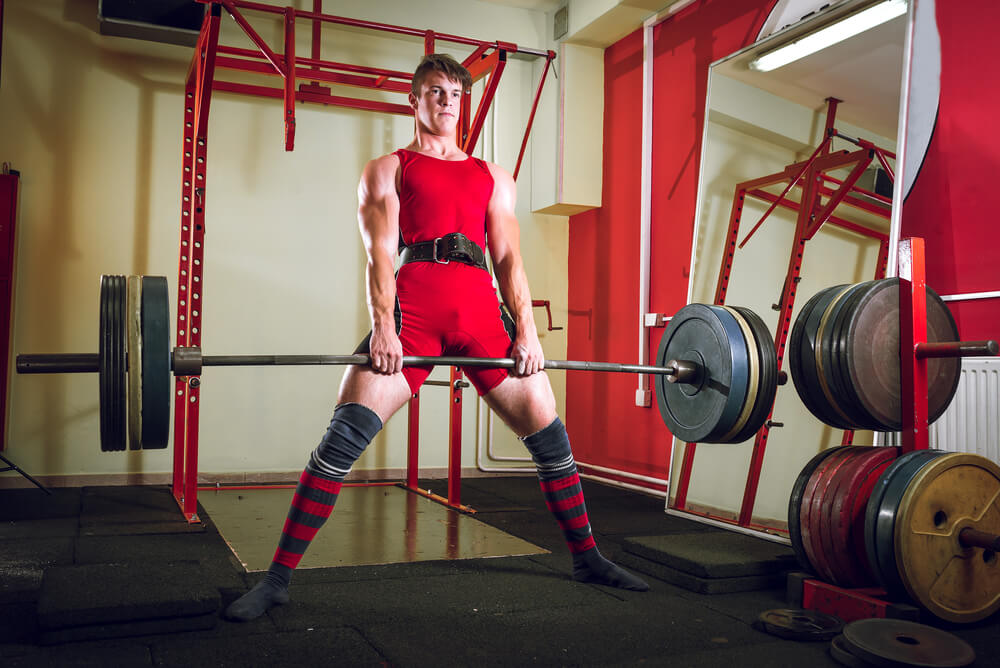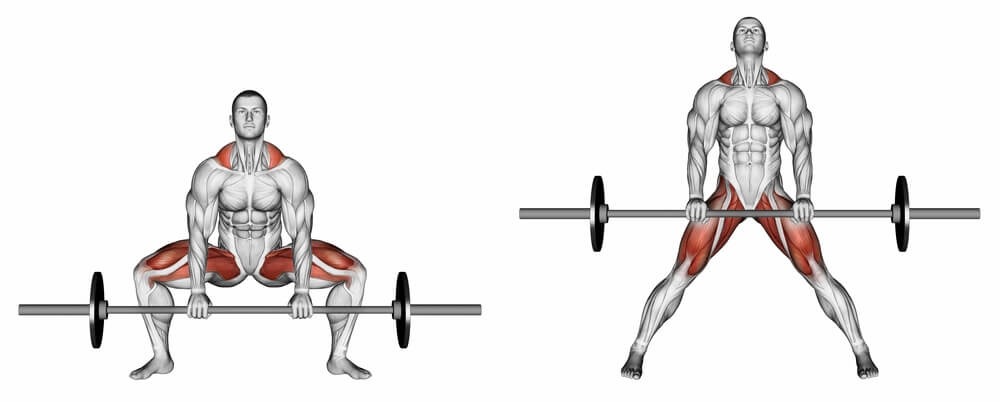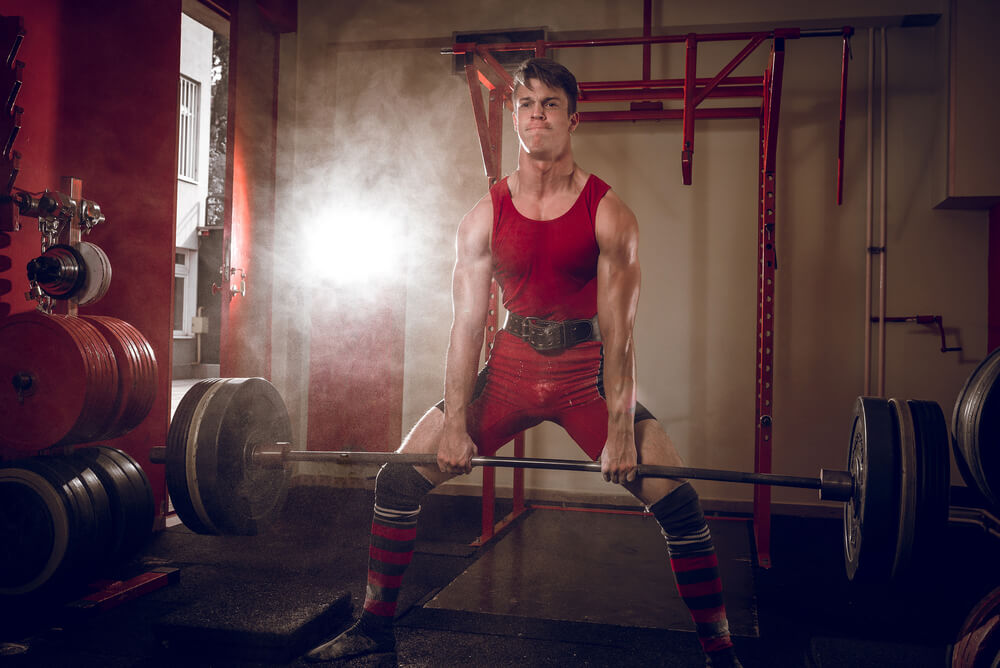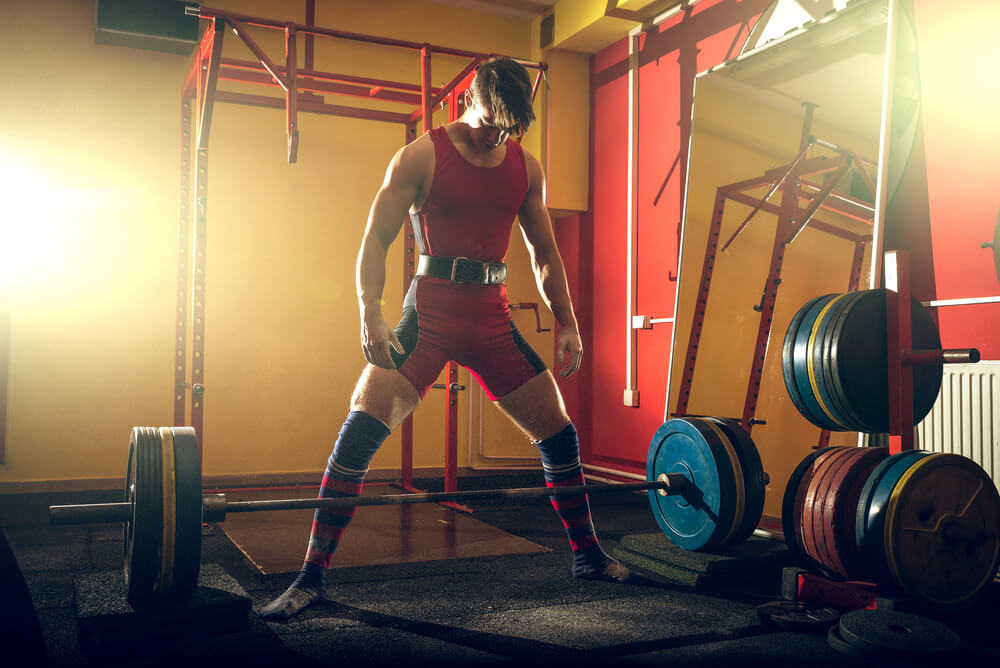
With the largest muscles of your body located in your legs, hitting your legs is a must. You’ll burn through more calories (both during your workout and post) as you push closer to your fitness goals. Today we will talk about the sumo deadlift and how it can help you!
The sumo deadlift might be a lift you’ve heard a bit about, but what makes it so great?
After all, when it comes to sheer physical fitness, the imagery of a large, sumo wrestler likely does not pop into your head.
The move itself doesn’t have much to do with actual sumo wrestling, but it does have plenty to do with training your lower body. We’ve got all the answers to your sumo deadlift questions right here, including whether or not you should be using it in your workout.
Sumo Deadlift vs Conventional
I’m sure you have heard different names like Romanian deadlift, sumo dead lifts and people even ask what is the difference between squat and deadlift?
Over time, you’ve probably come to feel comfortable with your current weight training workout.
You know what to expect from the lifts, how to perform the lifts accurately and how much weight you can do on each.
However, constantly tinkering, adding and subtracting lifts during your workout is important for a variety of reasons.
First, it keeps your muscles confused. Muscle confusion is vital towards building both strength and size. Over time, your muscles become accustomed to performing certain moves. Once this transpires, the impact of the lifts is greatly diminished. You’ll no longer feel sore the next morning after workout out and both size and strength gains start to taper out. Adding in new moves while removing others keeps your body on its toes. A constantly guessing body is good in the world of weight training and strength gains.
Secondly, a new lift trains your body in a slightly different way.
Even if you replace one gluteus lift with another, there is a slightly different movement, which causes the muscle fibers to move in a slightly different way. This even minor adjustment forces your muscles to reset and adapt to the new moves, resulting in the continual growth and strength improvement you won’t receive by only performing the same basic lifts every single time you go to the gym.
All of this is exactly why you need to look closer at new lifts you are not yet performing during your routine, including a sumo deadlift.
What is a Sumo Deadlift?
The second half of the lift’s name should at the very least give you an idea as to what you’re doing.
With a traditional deadlift, you start with a loaded barbell on the ground in front of you during your deadlift program.
Lowering yourself into an almost squat position with your legs around shoulder width apart, you grab hold of the barbell in front of your body, keeping your back straight. You then explode upward, holding onto the bar with your hands as your lower body pushes you up. The important lift works the majority of your lower body, in addition to your lower back and, depending on how you pull your shoulders back, you can work your traps as well.
The sumo deadlift is a similar lift.
The only real difference, at least in terms of performing the lift, is leg placement.
This is where the name of the lift comes from. Conjure up the imagery of a sumo wrestler preparing for a bout. You probably see a very large Japanese man, wearing very little clothing, squatting down with his legs spread extremely wide, as if to make sure you know he’s wearing very little clothing. It is the width of the man’s stance that forms the basis of the sumo deadlift. Your stance is what changes. Your legs kick out too far beyond shoulder width, with your thighs opening up.
From here, the move is performed in a similar manner to that of other deadlifts.
Sumo Deadlift Form & How to Perform a Sumo Deadlift
The sumo deadlift is not something you probably done all too often at the gym. Of course, depending on what gym you go to you may not see all that many deadlifts done either.
However, if you have experience performing a traditional deadlift you shouldn’t have too much trouble performing this variation.
With the change in leg position, you shift the emphasis of the muscles used (more on this later). To perform the lift though, load up your barbell. The first time you perform the lift you’ll want to go lighter until you know how your body will respond.
Stand with the loaded barbell in front of you. Spread your legs out beyond shoulder width. You likely will feel a slight stretch in your inner thighs. If you haven’t warmed up this part of the body yet, it is a good idea to ahead of time. You can even perform some weightless squads in this position, just to activate the muscles before jumping right in.
Take hold of the barbell while keeping a flat, straight back.
You’ll need to bend at the hip to grab the bar. Your grip will be the same as a deadlift, so right around shoulder width apart. You do have some slight hand placement variations though, depending on what you like. Overhand, underhand and mixed grips work fine with this lift. Feel free to experiment a bit to see what works for you. Switching the grip can rotate the emphasis of the lift to include more of your quads and less of your hamstrings (using the mixed group option and rotating can give you the best of both worlds)
Lower yourself down with the hips.
Due to your wide stance, your thighs will almost be parallel to the floor already. Make sure to keep your head looking forward and your chest up while also maintaining a straight back. Most of the weight will be placed at the back of your feet. Explode up, pushing down with your feet as you stand. While your arms hold onto the bar, it is your lower body that pushes yourself up.
When the barbell passes your knees, push your hips into the bar as you pull your shoulders together. This adds an extra squeeze on your shoulders. For an extra burn and shoulder workout, maintain the shoulder squeeze for a beat before returning to the starting position. Maintain your form all the way down, then repeat.
The Purpose of the Sumo Deadlift
So, you’re doing essentially the exact same move as a traditional deadlift.
Why in the world is the sumo deadlift necessary then?
It comes down to the stance and how it shortens the lift. By pushing your legs outward, it puts more of the weight directly onto your hamstrings. With a narrower stance, the weight is distributed throughout your hamstrings, gluteus, and even a bit into your quads and calves. Instead, it is almost exclusively on your hamstrings. This makes the sumo deadlift one of the best hamstring building exercises you’ll find (especially when combined with the sumo squat).
You also hit the hamstrings in an entirely different way than most other lower body lifts. Because you’re standing in a similar position for most hamstring exercises, you work the muscles in the same way. The sumo deadlift though works your hamstrings right around the inner thigh area. This way, it doesn’t just target the area directly under your butt but instead it works the inside hamstrings as well.
By improving the strength of the inner portion of your hamstrings you’ll improve upon just about every other lower body lift you perform as well.

Muscles Used in the Sumo Deadlift
The traditional deadlift is one of the, if not the very best lift you can perform. This is because it hits just about every muscle group on your backside. It’s also why you shouldn’t just drop the traditional deadlift in exchange for another exercise. However, you can (and possibly should) add the sumo deadlift. Much like the regular deadlift, the sumo deadlift hits a large number of backside muscles.
Your hamstrings and glutes are the main targets of the lift. You’ll hit this area (especially your hamstrings) more than a regular deadlift due to the wide stance.
Your abductors are hit heavily as well. Your quads are also hit, although the exact impact on your quads heavily depends on how far apart you are able to place your legs. Your forearms are hit significantly with the lift as well, although this is to be expected whenever holding onto heavy weight where the legs perform the actual lifting.
In terms of secondary muscles hit, just about everything in your back is touched upon. Due to the shoulder “crunch” you perform upon hitting the top of the lift, your traps receive a good amount of impact from the lift. Additional stabilizer muscles for this particular lift include your hip flexors, abdominal muscles, shoulders and rhomboids (All About Powerlifting, 2017).
Who Should Use Sumo Deadlifts?
This is truly a great lift and it is something everyone should at least try.
Of course, if you spent time at the gym on every main lift variation, you’d never leave. You can add the sumo deadlift right along side the regular lift, or you can use it instead of the regular lift, alternating every few weeks in order to keep your lower body muscles confused (and to keep your workout fresh and interesting).
In terms of who should use the sumo instead of the traditional deadlift, it comes down to injury potential. The sumo deadlift places less strain on the lower back and spine.
So, if you suffer from lower back pain or commonly injure this area, switching to the sumo deadlift can give you the ability to perform a deadlift without as much of an impact on your lower back.
Sumo Deadlift Workout Example
As is the case with most power lifting moves, it all comes down to whether you’re looking to build strength or power (primarily).
When first performing the lift, always start off light.
Even if you are a seasoned deadlifter, the shift of muscular emphasis requires your muscles to adjust, so you likely won’t lift as much early on while your body adapts.
If you’re going for sheer strength gains, you want to shoot for four reps. Do this three times. You likely have other lifts to perform, so stop there and move on. If, however, you’re short on time or you’re ending the day with the sumo deadlift, add a fourth set but use lighter weight and shoot for 12 reps.
This can help burn out the rest of your energy and push your lower body muscles to failure.
If, on the other hand, you’re going for pure size gains over strength gains, shoot for the eight to 12 rep range.
If you can hit 12 and you’re not struggling you need to increase the weight. 9 or 10 reps is the sweet spot. Do this three times, and always increase the weight if you hit 12 the time before. You want to push your body towards failure. If you’re hitting 12 and you still have lifts left in the tank, you’re not getting everything out of it you should be (EXRX, 2017).
Conclusion
The deadlift has always been one of the very best lifts you can do. Thanks to its ability to hit basically every muscle group in your back, the lift should not be skipped.
However, is there room in your workout routine for a second deadlift?
The sumo deadlift is an excellent lift on its own, targeting your lower body (especially the hamstrings and gluteus) in a slightly different angle than the regular deadlift. If you have lower back pain and have avoided the regular deadlift, you finally have an option (and no more excuses). You can add in the lift on top of your current deadlift, or you can rotate it in and out to keep your muscles guessing every few weeks.
However you do it, the sumo deadlift is one lift you should not skip on if you want to maximize your time at the gym and see impressive results.
-Terry Asher
Terry Asher
Latest posts by Terry Asher (see all)
- Better Family – Product Review Liquid Daily 2 oz - Dec 16, 2024
- Post-Workout Recovery: The Key to Optimal Performance - Nov 25, 2024
- Pre-Workout Supplements – Everything You Need To Know - Nov 18, 2024












[…] post Sumo Deadlift – How To Use Them In Your Workouts appeared first on Gym […]
[…] Sumo Deadlift – Use Them Like This In Your Workouts: […]
[…] “Big Four,” is the squat, deadlift, bench press, and shoulder […]
[…] sumo deadlift is done by placing your feet at a wider stance with your hands on the inside of your thighs. The […]
[…] of different deadlift variations, but the four you’ll run into the most are the conventional, sumo, stiff-legged, and the romanian deadlift. In terms of powerlifting and deadlifting in competition, […]